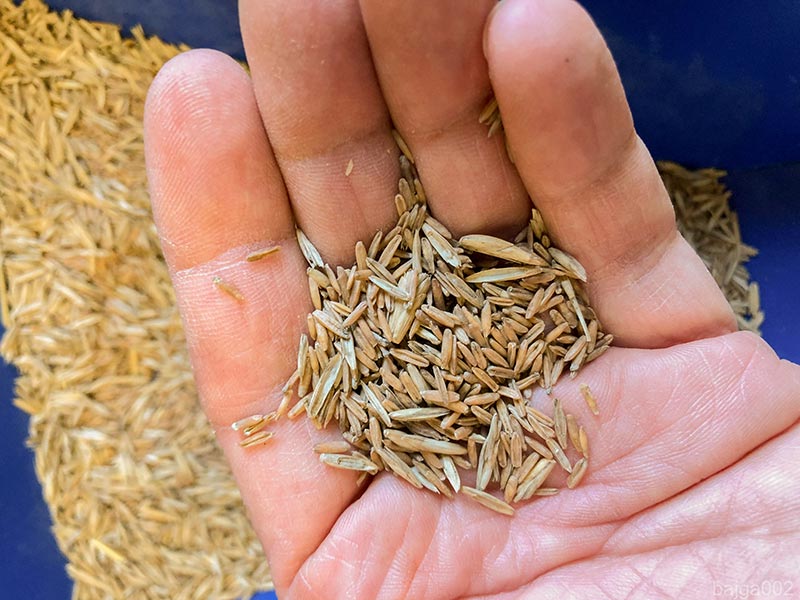

MN-Clearwater wheatgrass seed, the grain of which threshes freely from the hulls 63% of the time. Credit: Brett Heim
Wheatgrass is packed with beneficial nutrients, making the crop a popular superfood. And now, more farmers will have access to grow this beneficial crop.
Historically, wheat grass has been used as a crop in animal feed. However, a partnership between The Land Institute and the University of Minnesota changed that.
The University of Minnesota recently released the first variety of food grade wheatgrass for public use. Now this eco-friendly and profitable crop can also be commonly grown as human food.
“The Earth Institute has been growing intermediate wheatgrass since 2002,” explains James Anderson, a professor at the University of Minnesota. “Developed using germplasm provided by The Land Institute in 2011, this variety of wheatgrass is the first available for public use.”

Ears of MN-Clearwater wheat grass before their pollen shedding. Credit: Prabin Bajgain
The new variety, called MN-Clearwater, was produced by crossing seven wheatgrass parents with the desired qualities. These qualities include high grain yield and seed size, which are ideal for farmers. Breeders have been successful in domesticating this perennial crop that provides benefits for both farmers and the environment.
“Because wheatgrass is perennial, it is known to be a soil builder,” said Anderson. “It provides ground cover throughout the year.”
Ground cover prevents soil and nutrient runoff during heavy rains. Wheatgrass also has deep, dense roots that capture nutrients before they reach groundwater. This helps protect groundwater-based water systems.
Other benefits of this new variety of wheat grass compared to other crops such as corn and soybeans are:
- Less soil loss from the field;
- Fewer chemicals and fertilizers entering the groundwater system; and
- Improved carbon storage.
There are also economic advantages for the farmer who grows wheat grass. As a perennial crop, wheat grass uses fewer fertilizers and machinery than annual crops.
“Wheat grass can reduce the growth of certain weed species,” Anderson explains. Natural weed control also reduces the potential costs of herbicides.
For farmers, the great advantage is that they only have to plant once every three years and they will have multiple harvests from a single crop.
“But the farmer is not the only one who benefits,” Anderson explains. “As the first food grade wheat grass, food processors and consumers can also see a benefit.”

Wheatgrass plant breeding nursery in St. Paul, MN. Credit: Prabin Bajgain
End users are always looking for new items. MN-Clearwater wheatgrass provides new flavors and nutritional properties that can be added to food products.
Harvested wheat grass goes well with wheat-based products. It can be used as a replacement for wheat, but it is better to use it with it. By using both wheat and wheat grass as ingredients, the product can maintain its functional and baking properties while offering new flavors.
The first registered food product to use MN-Clearwater Wheatgrass was a beer from Patagonia Provisions, and other products include various locally brewed beers and a limited-edition cereal from Cascadian Farm.
###
Reference: “‘MN – Clearwater’, the first food grade intermediate grain (Kernza perenne) cultivar” by Prabin Bajgain, Xiaofei Zhang, Jacob M. Jungers, Lee R. DeHaan, Brett Heim, Craig C. Sheaffer, Donald L Wyse and James A. Anderson, May 14, 2020, Plant Log Journal.
DOI: 10.1002 / plr2.20042
More information on MN-Clearwater, the first variety of food grade wheatgrass for public use, can be found at Plant Log Journal using the DOI link above. Funding for this work was provided by the Renewable Energy and Environment Initiative, the Minnesota Department of Agriculture, the Forever Green Initiative, and the General Mills Foundation.